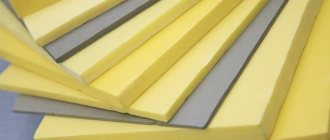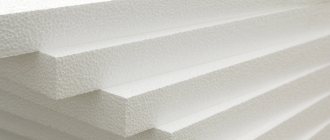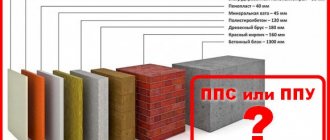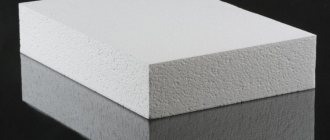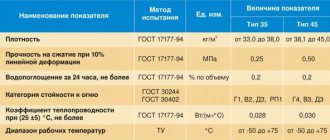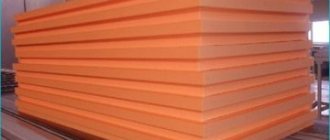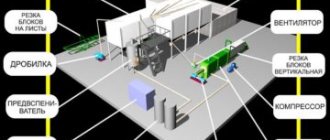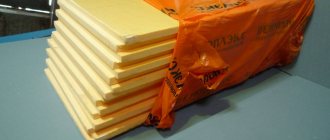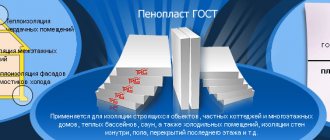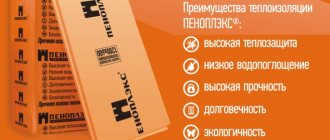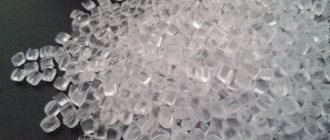Foam plastic is one of the most popular thermal insulation materials, occupying about 10% of the entire thermal insulation market in Russia.
The high demand for polystyrene foam is due to its low cost and excellent thermal insulation properties, which are 5 and 15 times higher than those of wood and brick, respectively. The scope of application of polystyrene foam is very diverse:
- construction sector (thermal insulation material for floors, roofs, foundations);
- trade sector (packaging material for goods);
- the sphere of production of goods (production of furniture, refrigerators, life jackets, tailoring, etc.);
- shipbuilding (production of buoys, pontoons, boats);
- outdoor advertising.
How to start a foam production business
Business planning should begin with an assessment of the product market. According to experts, to start a business successfully, you need to have guaranteed demand. Despite the fact that the volume of construction is increasing, which naturally increases the demand for thermal insulation materials (by ~ 10% per year), the competition among foam plastic manufacturers is quite serious. In addition to the large number of small and medium-sized enterprises in Russia, the volume of polystyrene foam exports from China is growing from year to year.
However, the market is still far from saturated and favors the entry of new players. Entry barriers are not so high, and the total investment for creating a small line (40 m3 per shift) is about 800 thousand - 1.5 million rubles.
What equipment to choose for foam production
To create a mini-enterprise for the production of foam plastic, you will need to purchase:
- pre-foaming agent;
- automatic feeding and dosing system of granules;
- foamed plastic receiving hopper;
- block molds for making foam plastic;
- drying unit (fans);
- tables for cutting foam blocks;
- waste crusher;
- steam generator;
- pneumatic transport for transporting granules and control panel;
- Packaging equipment;
- industrial scales.
Components of the production line
Foam production line
The automated foam production line contains the following units:
- pre-foaming agent;
- drying bunker;
- molding blocks;
- cutting machine;
- steam generator;
- crusher;
- dispenser for raw materials.
The pre-mixer is a chamber into which the feedstock is supplied using a screw, which is installed at the bottom of the device. Steam is supplied to the chamber through spun holes. Both of these processes are automated and can be regulated by the worker using the control panel.
Pre-foamer characteristics:
Press machine for foam plastic
- power consumption – 1.5 – 2 kW;
- maximum voltage – 380 V;
- volume – 700 l;
- maximum productivity – 300 kg/h;
- camera weight – 150 kg;
- dimensions – 1380*900*2200 mm;
- cost – 182 thousand rubles.
The drying hopper receives the foam mass into the first compartment, where, under the influence of a strong air flow (fan-fed), the initial drying takes place. Then the granules flow by gravity into the second compartment, equipped with a pneumatic transport mechanism, which directs the mass into the storage bunker. Characteristics:
- power consumption – 5 kW;
- voltage – 380 V;
- productivity – up to 30 m3/h;
- weight – 100 kg;
- dimensions – 5000*1200*1000 mm;
- cost – 100 thousand rubles.
The formation of an array of foam plastic takes place in the molding block. This process is carried out under the influence of water vapor. The granules increase in size again, and due to the confined space, they stick together. The block has a rigidly fixed side wall, a hinged wall and two end doors. Characteristics:
Forms and products for foam plastic
- dimensions – 1200*1500*750 mm;
- productivity – 2.5 m3/h;
- weight – 550 kg;
- cost – 242 thousand rubles.
A steam generator produces water vapor by heating water to high temperatures. The steam generator can be powered by electricity, diesel fuel or gas. The cheapest, in terms of the cost of combustible material, is gas, and from a safety point of view, electric. The latter costs half as much as diesel or gas. Characteristics:
- power – 35 kW;
- dimensions – 700*400*400;
- weight – 25 kg;
- water consumption – 40 l/h;
- productivity – 40 l/h;
- the cost of an electric one is 190 thousand rubles.
A machine for cutting solid foam plastic processes the layer with hot strings lengthwise and crosswise in accordance with the required parameters of the finished blocks. Characteristics:
- dimensions – 1300*1600*800 mm;
- weight – 300 kg;
- productivity –30 m3/h;
- cost – 150 thousand rubles.
The crushing unit is designed for waste processing. This mechanism is not always included in an automated line, but its acquisition is economically justified - production becomes waste-free. The recycled material can be added to the feedstock at the initial stage. Characteristics:
- power – 4 kW;
- productivity – 5 m3/h;
- weight – 100 kg;
- dimensions – 1500*1000*400 mm;
- cost – 65 thousand rubles.
Thus, you can buy a polystyrene foam production line for 929 thousand rubles. If financial opportunity allows, it is better to additionally equip the line with scales for raw materials, hoods for the pre-foamer, and a line for packaging. These components will simplify the production process.
Raw materials needed for the production of polystyrene foam
The main raw material for the production of polystyrene foam is expanded polystyrene PSV-S in granules. Much depends on the quality of raw materials and their shelf life. So, the older the polystyrene, the longer the foaming process and the more difficult it is to achieve the required density of the foam granules.
The most popular brand of polystyrene foam is PSBS 25F, which has longer curing times than other brands (PSB-S15, PSB-S25, PSB-S50, etc.). Using this brand allows you to achieve a more even surface with fine granules, on which plaster and paint can easily be applied.
To produce 1m3 of polystyrene foam, about 15 kg of polystyrene is required. The cost of 1 kg of polystyrene depends on the delivery region and manufacturer. For example, the price of average quality Chinese raw materials is 60-70 rubles/kg. Accordingly, the cost of raw materials for the production of 1 m3 of polystyrene foam is: 70 rubles. *15 kg = 1050 rubles. To ensure the operation of one 8-hour shift with a productivity of 40 m3 of foam, it will take about 42,000 rubles. This is a significant initial expense when starting a business with little start-up capital. We must not forget about this when planning a business.
Foam production technology
The production technology of foam plastic includes such stages as: primary and secondary foaming, drying, curing in air, molding and cutting of finished products.
The detailed production process is as follows: First, the pre-expander is turned on and the required number of polystyrene granules is loaded. Then steam is supplied to the pre-foamer and when the granules reach the required level of foaming, the steam supply stops. The foamed granules are unloaded and transported to the dryer. After drying, the granules are fed into a bunker, where they are stored for 12 hours. Next, the aged granules are loaded into a block mold, where they are vacuumized.
The granules are kept under pressure for a certain time, after which the pressure is released and the block mold is cooled. Then, using a pneumatic pusher, the finished block is unloaded through the wall of the block mold. The division of finished foam sheets is carried out on a special machine for horizontal cutting. The resulting scraps after dividing the sheets are placed in a crushing plant, crushed to the required fraction, loaded into a hopper, where in a ratio of 1:8 they are mixed with primary foamed granules and reused.
Technological process
The first and main stage is polystyrene foaming. The granules are placed in a chamber where, under the influence of steam, the process of increasing the volume of the balls begins.
Polystyrene foaming machine
Depending on the required grade of foam, this process can be repeated. The result will be a lighter material. The next step is drying the finished mass in the aging bunker. This process continues for 12 hours, during which time the granules are filled with air and compacted. Then comes the stage of forming the blocks - under the influence of steam, the mass is heated and the granules are glued together. After cooling, the foam is ready for cutting in accordance with the required proportions. After another day, the material is ready for packaging and sale.
If you purchase a line for the production of expanded polystyrene, this is one of the types of foam with improved characteristics; the technology is complemented by the use of an extruder. At the initial foaming stage, butane or CO2 is added; under the influence of these components, the granules are enriched with talc particles, which form the core of the bubble. Thanks to this, the mass becomes more durable, the coefficient of thermal conductivity and thermal insulation increases. Further, the manufacturing process of expanded polystyrene is carried out by analogy with polystyrene foam.
Step-by-step plan for starting a foam production business
To open a workshop for the production of foam plastic, you will need a premises with an area of at least 250 m2, including warehouse space. The ceiling height must be at least 5 m, the room must have good ventilation (due to the hazards of production), water supply, electricity connection (380 W) and heating (at least +15 degrees). At least 50 m2 of space is allocated for the warehouse of finished products, with mandatory insulation from the production workshop by fire-resistant structures. The warehouse must have a canopy that protects the foam from direct sunlight and precipitation. Monthly rent for a premises of this size, depending on the region, will cost 50-100 thousand rubles.
The required number of workers is calculated based on the line productivity - one person per 6 m3 of foam per hour. Two workers will be required to operate two shifts. Workers' remuneration is piecework-bonus, that is, it depends on the number of blocks produced per shift, on average - 50 rubles/m3. In addition to production personnel, at least one general worker (10 thousand rubles), an accountant (10 thousand rubles) and a sales manager (15-20 thousand rubles) are required.
Properties of expanded polystyrene
Let's talk about each property more specifically.
Strength
Thanks to production technology, extruded polystyrene foam takes the lead in strength. Ordinary foam plastic cannot boast of such strength, which is why it is currently less in demand.
Using the extrusion method, you can obtain a material that is better for insulating, durable and resistant to moisture.
Thermal conductivity
One of the main properties of expanded polystyrene is its low thermal conductivity. Polystyrene foam consists directly of polystyrene and air bubbles in it. Since the air is securely contained inside, it serves as an excellent thermal insulator. This property allows the use of foam plastic for construction and insulation work. Due to the availability and relative cheapness of the material, this is a fairly profitable choice when heating your home.
Moisture resistance
Extruded polystyrene foam has a fairly strong resistance to moisture. Unlike regular foam, extruded polystyrene foam always remains dry. This property allows the foam to be laid in areas of greatest accumulation of moisture or leakage of liquids.
Which taxation system to choose for a foam production business?
The organizational form of the enterprise is individual entrepreneur or LLC (legal entity). Individual entrepreneurship is easier and cheaper to register than a legal entity. However, large wholesale companies prefer to work more with organizations rather than with individual entrepreneurs. Much also depends on production volumes - for small volumes, an individual entrepreneur is enough, then with an increase in production volumes and sales markets, it is definitely necessary to register an LLC. A legal entity can create branches and representative offices in other cities, and it is safer from a legal point of view - an LLC is liable for obligations only with property belonging to this organization, while an individual entrepreneur is liable with all property belonging to an individual (apartment, car, etc. .).
How much money do you need to start a foam production business?
The cost of purchasing equipment depends on the configuration, line productivity and taking into account delivery and installation, amounting to at least 800 thousand rubles (used ones are slightly cheaper). The most expensive components of the kit: steam generator - from 150 thousand rubles. and block form - from 100 thousand rubles. The cost of a full-fledged automated line with a capacity of over 100 m3 of polystyrene foam per shift amounts to several million rubles.
Let's calculate the economic efficiency of a foam plastic production enterprise with a productivity of 80 m3 per shift.
Initial data:
- Productivity per shift (per day) – 40m3
- Number of working days – 22;
- Production area - 250 m2, rental payments - 60 thousand rubles. per month;
- The number of production personnel is 2 people, the wage fund is 44 thousand rubles. (50 rub./m3);
- Payroll fund for other personnel: accountant – 10 thousand rubles/month, sales manager – 25 thousand rubles/month, general worker – 10 thousand rubles/month.
Capital costs: Purchase of a polystyrene foam production line worth 1.5 million rubles. The kit includes: a steam generator, a dryer, a block form BF 0.5, a pre-foamer, a receiving hopper with a control panel, tables for cutting blocks, an automatic granule feeding system, a waste crusher, a packaging machine, and industrial scales. The costs include delivery and installation of equipment at the customer’s premises.
Cost of raw materials: Expandable polystyrene PSV-S in granules will be used for the production of polystyrene foam. The price for 1 kg is 65 rubles. To produce 1m3 of PSB-25 foam plastic, 15 kg of polystyrene is required. The total cost of raw materials is: 15*65 = 975 rubles/m3.
Let's move on to calculating the total costs of polystyrene foam production per month, per shift and per unit of production.
According to the above calculations, the cost of production of 1 m3 of polystyrene foam is 1285.3 rubles.
Equipment
The production line includes the following machines (with approximate cost in rubles):
- pre-foaming agent – 150,000;
- steam generator – 60,000;
- secondary foaming unit – 30,000;
- receiving compartment - 140,000;
- block form – 90,000;
- steam battery – 60,000;
- crusher equipped with a fan – 40,000;
- cutter with transformer – 30,000;
- fan for aging bunkers – 120,000;
- cutting table – 30,000;
- steam boiler with a waste disposal device – 160,000;
- 2 liner bags for the bunker – 12,000.
The total cost of purchasing equipment will be 922,000 rubles.
What documents are needed to open a business?
To open polystyrene foam production you will need the following package of documents:
- register as an individual entrepreneur or register as a legal entity. IP takes less time and is more preferable from the point of view of financial costs;
- opening a current account;
- receiving statistics codes;
- registration with the tax office;
- obtain permission from the fire inspectorate;
- conclude an agreement for the removal and disposal of waste, garbage, etc.;
prepare internal documentation:
- collective agreement;
- employee employment agreement;
- staff job descriptions;
- internal labor regulations;
- safety regulations, etc.
Opening a workshop: step-by-step algorithm
The opening of a production workshop is carried out in several stages:
- Registration as an individual entrepreneur or legal entity. Doing business as an individual entrepreneur is much easier (including due to reporting), but some potential clients (large organizations) work only with legal entities. persons. The organizational and legal form also depends on the volume of output.
- Select equipment. It is recommended to consult with a specialist before purchasing.
- Select premises for the workshop. Install equipment into it.
- Hire staff, prepare for work.
- Select suppliers and purchase raw materials.
- Debug the process (resolve logistics issues, etc.) and begin production of expanded polystyrene.
No permit is required to begin work. You just need to settle the issues with the fire department.
The business production plan given in the article makes it possible to open a profitable business that will begin to generate net income within 3 months. Given the high demand and growth in construction volumes, this idea will allow the entrepreneur to organize a work process with little investment and quickly achieve success.
Do I need permission?
Obtaining a permit to open a polystyrene foam business is not required, with the exception of a fire inspection. There is no need to contact the health authority, since this type of activity is considered practically harmless
( 2 ratings, average: 5.00 out of 5)
Loading…
Similar business ideas:
- TOP 30 business ideas with minimal investment
- Where to start shoe production and is this business profitable?
- Chatbot marketing: is it possible to get a good income...
- TOP 30 business ideas without investment
Foam plastic for thermal insulation
If you have certain skills, you can make glue for foam plastic with your own hands and the foam itself. Therefore, you need to be patient and have supplies to obtain this product.
To produce polystyrene foam, you do not need to purchase any devices or units; the entire process is done using simple means.
But it is worth remembering that homemade polystyrene foam does not have the same properties that a similar material obtained in a factory has. So it will be difficult to count on guarantees of high quality.
If you want to make glue for polystyrene foam with your own hands, then you will need cottage cheese as a starting material, which is mixed with slaked lime to form a strong mass that can reliably fix the heat insulator. Or you should use wood glue, which you can also make at home.
